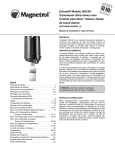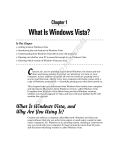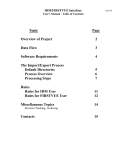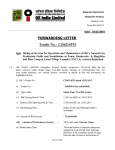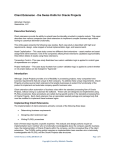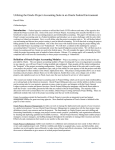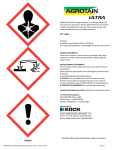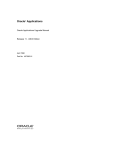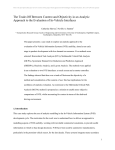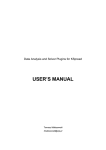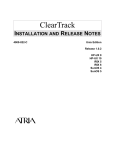Download Yes - New Page 1
Transcript
March 1999 Volume 3.2 Atlanta OAUG Tips and Techniques www.atloaug.org Editor’s Comments The national OAUG conference will be in San Diego in mid April. I look forward to seeing you there. J From: Laura Bray [email protected] Next Meeting Friday, March 19 at 9 AM @ Oracle offices, Abernathy/GA400 Hosted by: D'Lesa Medlin, St. Paul Software Reservations via email to [email protected] Agenda Upgrading the Oracle Applications: Going Beyond the Technical Upgrade - Neil Burt, KPMG Consulting Oracle's Front Office Applications - Michelle Rubio, Oracle Corp The accepted papers should be posted to our web site by Feb 10. We won't have a preliminary agenda ready until several weeks after that, but the accepted papers should give you a good idea of what's planned. not a customization and is done on-line through the Application Developer responsibility. Upgrades System Administration From: "Chalmers, Jeff" <[email protected]> Page B-22 of the Oracle applications Installation Manual for Unix. Talks about table registration. The documentation states that you only need to register custom tables that use flexfields. z From: "D'Agostino, Keith" <[email protected]> You cannot just execute the Journal Import program from the command line via CONCSUB. There is a row which needs to be inserted into the GL_INTERFACE_CONTROL table. The id for this row needs to be passed as one of the arguments to the Journal Import program (GLLEZL). Ì From: "Agiwal, Yogesh" <[email protected]> Make a 10SC form read-only by adding the string QUERY_ONLY=YES in the Form Function definition parameter field. This will set all database blocks to non-insertable, non-updateable, and non-deleteable. This is From: Joe Gamache <[email protected]> You should have a definite methology for applying patches. Ours is: Carefully read the Readme files. Include your Sys Admin, DBA and Super Users in the evaluation. Document what the patch 'touches' or changes and plan to test those items. Apply to the patch to your TEST instance (Make sure you have current data in your TEST instance). Test your plan. Have the Super Users agree all is OK. Only then do you apply the patch to your Production instance. I know it sounds rather anal, but once you've applied a "bad"patch you'll understand: Especially a MegaPatch that has a client-side and server side. From: Eric Tegenfeldt <[email protected]> You are absolutely correct about the methodology. In our case, we had done all of those things, including reviewing the read-me's, testing intensively for 2 weeks with the Super Users in a test database first, etc. My point was simply that from now on, my methodology will not only include the steps you mentioned but also a thorough analysis of any SQL scripts embedded in the patch plus a check in the test database for rows created or updated during the application of the patch. From: Joe Gamache <[email protected]> One thing I forgot to add. after applying any patch, especially a MegaPatch, check for invalid objects and reconnect. Financial Apps GL From: "Brian Houlahan" <[email protected]> The quickest (and most reliable) way to add code combinations to Oracle is to set up a 0 value Journal using Journal Import, then run the import. This process produces an audit report that can become a part of your migration documentation. To run Journal import populate the GL_INTERFACE table using SQL*LOADER. GL_INTERFACE is a very simple table. There was a paper from OAUG a few years ago (Name Unknown) that actually provided the SQL*LOADER Control file for this process. ˜ From: [email protected] When you start the Journal Wizard in GLDI, you'll see a box in the lower right corner with two yellow squares and a couple of lines. Hit that and you can customize your template. 2 Atlanta OAUG Tips and Techniques Ë Q. On the GL interface table we found records of journals from purchasing with status's - P. Does anyone know what the P is standing for? From: "Richmeier, Steve (Consultant)" <[email protected]> Basically what this means is "Partial" or "Processed" Example is that I import 100 lines in a journal each row (100 values) in the interface will have a value in the status. If one row has an error during validation then the status will be "E". The remaining 99 rows would have a "P" meaning those rows are okay but there are other rows that have caused the import to fail. Also the "P" then keeps those records from showing up in the form JOURNAL / IMPORT / CORRECT like wise the "E" status records will show on the form. AP Q. I'm implementing Oracle AP 10.7 SC. When an invoice has been approved, and someone changed the terms date or payment term later, the status of the invoice is still approved. For security reasons we don’t like this. We want the invoice status to be changed to need reapproval, or to make these information cannot be changed anymore after approval process. From: "Fischer, Erik" <[email protected]> Set up a procedure to post all entries from Payables to the General Ledger nightly. Once the invoice is posted to the GL changes cannot be performed unless you reverse and re-enter. When you do this, you need to re-approve the invoices. Ë Q. Our group has about a thousand vendors. We are using multi sob and multiorg. A vendor may belong to more than one company, so we will have to create multiple sites, that is one site per company. We were exploring the possibility of importing vendor information into the Vendor Tables. When we contacted Oracle, we were informed that there is no direct interface for importing Vendors into Oracle on 10.7. Is there any way out for this. Importing Vendors would enable us to save a lot of time in our implementation efforts. From: "Tom Perkins" <[email protected]> At a previous implementation, we considered importing 1500 vendor sites, but quickly estimated that it would be less time-consuming to enter them by hand. I believe we were considering a custom program (with all its testing prior to the actual import) since there was no interface table. In addition, the data was not in a format which could easily be imported. Field data was all over the place, and we would have had to spend dozens of hours moving it around in the legacy system prior to the actual import process. As a result, we identified all the vendors which would be required at startup, including those with open POs and open invoices. We had the buyers hand-key them in and called it "training". Since they were unfamiliar with the system at that point, it represented a great hands-on training opportunity. And we only had to add about 500 of the original 1,500 to go live. The rest were added on an ongoing basis when new POs or new invoices were required and no existing vendor was found to match with. FA Q. We have the need to track assets that have been "surplused". This means that the item has been put on a list indicating that the agency wishes to dispose of it. The state keeps a composite list of surplused items to coordinate the disposition of all of its assets. Once another agency buys the assets or it has been on the list a certain amount of time, the agency officially retires the asset. From: "Krishna Rao" <[email protected]> I think a separate asset category could be setup to track assets that have been surplused. For example: (Equipment.Copiers.None) Asset Cateogry could be setup for classifying the regular assets. Another Asset Category (Equipment.Copiers.Surplus) for classifying the assets which are surplus and pending disposal. You will be able to generate the reports by asset categories and also subsequently retire the assets. Ë Carla Miller <[email protected]> To avoid retirement problems, it's best to have the tax book's depreciation calendar match the corporate book's. The tax people may only care to have depreciation run yearly or quarterly, but FA won't let you retire assets in the same period in which they were placed in service, so if you place an asset in service and retire it, say, in the same year, you'll have a problem. AR From: "Ellen Porterfield" <[email protected]> If you cancel zero amount invoices you must be assuming the general ledger coding is an in and out situation. In many cases an invoice may be charged to one general ledger account and credited to another to net at zero. In those cases voiding the invoices would be unwise. ² Does anyone know how to resolve app11959 "CM date cannot precede the date of the transaction being credited"? From "Feeney, Brian" <[email protected]> Look at the GL date of the Credit Memo in question. An example is an invoice has a date of 12-DEC-1998, but was brought into through AutoInvoice with a default date of 31-DEC-1998 (or some later date than the invoice date). As a result, if you try and send a Credit memo through with a date before 31-DEC-1998, the system will give you the error message you reference. To see if this is the reason for your problem, go to the Transaction History form and look at the GL Date for the transaction in question. You will probably see that it is later than the Invoice Date. The way to resolve it is to make the date of the CM equal to or after the GL Date. Distribution Apps PO From: [email protected] To convert POs from the legacy system to Oracle, you will have to populate 4 tables. Tables • • • • PO_Headers PO_LINES PO_LINE_LOCATIONS PO_DISTRIBUTIONS Be sure to populate these tables in this order. Note: IT IS VERY IMPORTANT TO VALIDATE YOUR DATA BEFORE POPULATING THESE TABLES. From: "Joe Arnold" <[email protected]> 3 There are two other tables you need to populate depending on the current state of your PO's and PO Lines. If your PO's are open and have been approved, you will have to make two entries in table PO_ACTION_HISTORY. If your PO's are open and still have unreceived lines, then you have to make entries in table MTL_SUPPLY. The best way to determine what you have to populate is to open a PO, and then run it through approval, receipt, invoice match, and invoice approval phases; checking the table entries through each phase. Also running a database trace as you go through the phases really helps. For the receipt phase, numerous other tables come in to play. Really review the Inventory, Purchasing, and Payables Technical Reference Manuals !! MFG Apps Q. How do we set up an item to be purchased (as a normal buy part) or processed as an outside purchasing item? If we are out of a certain purchased part we can take another purchased part and send it to a vendor to be processed into the item we originally wanted, From: "Magnuson, Todd" <[email protected]> This sounds like you are going to have to create a bill of material for the part you desire that has the other part as the component. Your outside processing item would be attached to the routing for the part you are out of. You would then create a WIP job, issue the purchased part that you have in stock to it, and move the qty into the queue of the outside processing operation. This would generate a requisition to send the parts outside under the outside processing item, the PO gets placed, and the parts are sent to your supplier. When they come back into the WIP job you would do a completion transaction to bring the item into stock. I know this sounds like a lot of set up - it is. However it's the only way we have found to accomplish this feat. Q. Does anyone know how to set up an item's attribute if it is a mainly a Buy part, but can also be a Make part ? From: "Jason Babicky" <[email protected]> Atlanta OAUG Tips and Techniques Setup as a Make item, then activate Purchase and Purchasable attributes OE Q. When we place an order on an item which has less stock available than the quantity that we are trying to ship it does not ship the available quantity. From: Stephanie Magid-McCurdie <[email protected]> Has your order cycle been defined to allow partial quantities? You can pick release as work in process completes partial quantities or wait until the entire quantity has been completed before releasing pick slips. You control this when you define your cycle action prerequisites for Pick Release. If you choose Manufacturing Release - Work Order Partially Completed, Pick Release releases any available completed quantity. When you choose Manufacturing Release Work Order Completed, Pick Release does not attempt to pick the order line until work in process has completed the full quantity. will need some other modules. temporary interfaces to From: "Venkatesh, Masoor" <[email protected]> I recommend attending my white paper presentation 'TIPS ON IMPLEMENTING ORACLE PAYROLL' at the upcoming Spring OAUG in San Diego (April 18 - 22). Here are the areas you need to pay close attention to: • Legacy Migration of Employee Benefits and Deductions • Balance Loads • Time Collection and PayMIX • Payroll Runs and multi-threading • Custom Reports and balance packages You should test your data load process, employee deduction load process, and if possible come up at the beginning of the calendar year or at least at the beginning of a calendar quarter. Remember that for US Legislation Payroll, time periods are based on pay dates and not payroll end-dates. & HR/PAY Q. What are typical payroll processing times? From: "Rick Sutton" <[email protected]> To utilize the HR/PR API's a new tool, DataPump, has been provided in replace of the custom development of a wrapper for each API. It is available as a patch from support. & Q. Do you have any recommendations or suggestions regarding testing, hardware, and payroll schedules for a major Oracle Payroll implementation? What would you do differently if you could do your Payroll implementation over again? From: [email protected] I can't stress enough to test, test, test!!! Test your balance loads, by running all of your quarterly and annual tax reports, compare to your current payroll. If you do not do this, you will pay the ultimate price at year end. Corrections to these balances are complicated and time intensive. You want to find all your balance errors before you start running a live payroll. If it is possible to bring up your employee population in small increments rather than all at once, that would give you time to iron out any missed bugs during testing. The draw back to this is that you will need to maintain two systems for a while and you From: "Venkatesh, Masoor" <[email protected]> Payroll run times depend on a number of things including the server processing speeds, number of CPUs, tuning, deductions elements. One of the best ways to speed up your Payroll processing is by using the maximum number of threads. This essentially chunks your payroll runs into smaller segments of employee population and runs them concurrently. I will tell you what it takes at one of our implementations - about 2000+ employee population, SUN Enterprise Server 3500 with 4 CPUs and multi-threaded to support 8 threads (payroll runs use all 8 threads) - it takes less than 2 hours. NOTE: The first payroll run will take 4 to 5 times the normal processing time. Workflow Q. We are beginning our implementation of workflow in conjunction with purchasing. Our intention is to use the e-mail notification functionality via Microsoft Outlook. Has anyone been through a similar implementation or can tell me any of the issues, steps, or bugs we may encounter. 4 Atlanta OAUG Tips and Techniques From: "Spiro, Bruce (HT-EX)" <[email protected]> Here are some of the high level issues that you will need to contend with. • Configure the wfmail.cfg file. • Activate the Notification Mailer. • Setup the Workflow Background process in the concurrent manager. • Setup the Requisition Import to run at specific intervals in the concurrent manager. • Create the WF_USERS, WF_ROLES, WF_USER_ROLES - There is an SQL Program that Oracle Provides that Helps with this. • Make sure that all users have proper accounts, if an e-mail message goes to someone for approval and there is no account the Workflow will send a NO APPROVER Message. • Make sure all users have proper supervisors setup in the system for approval purposes. • Configure the default error message with a proper user ROLE with the Workflow Builder. • Configure the Workflow Monitor (not a necessity, but a nice tool to have). Multi-Org Q. My company is planning to use the multi-org functionality. One of the requirements is to print checks centrally. Each check will include invoices from all organizations. This does not seem possible with standard functionality (or maybe it is, we can't find this detail of information in the multi-org documentation). Has anyone else experienced this problem? it seems like centralized payments would be a common requirement. From: "Ananth Swaminath" <[email protected]> You are right in noting that decentralized purchase and centralized Payables is NOT part of Multi-Org standard functionality in R10.7. The only workaround seems to be to simulate this environment by creating different responsibilities for Payables, all given to one person, thereby creating a centralized Payables function and getting around the issue. Ë From: Joe Maliszewski <[email protected]> Multi-Org does not affect GL. It is a configuration for the Sub-Ledgers (AP, AR, OE, PO, etc). Each Organization can attach to one Set of Books or a different Set of Books. Your choice. But obviously, it can only attach to one SOB. So the general answer to you question is No you do not have to create a new Chart of Accounts (Accounting Flexfield Structure) for each Organization. Extensions I am currently working for a client that is using 10.7SC. There are several requirements that will require modifications or additions to the existing application. At what point does Oracle deny support? From: Pat Burns <[email protected]> If you follow the steps documented in appendix C (I believe) of the Applications Object Library User Manual, you should not have a problem with support from Oracle. We have modified baseline forms and reports. When we experience a problem in a customized form or report, we attempt to re-create the problem using the baseline form or report. If the problem exists, we log a TAR with Oracle. If it doesn't exist, we know we have a problem with our customization and we fix it ourselves. Call for Contributions * - * We need your contributions to keep the content of this news letter fresh and topical. If you run across something in your daily interaction with the Oracle Applications that makes you think “isn’t that clever, strange, well done, impressive, difficult, etc.” drop me a note and we will share it with our readers. We especially appreciate contributions for manufacturing and project accounting applications. * - * Please, send me an e-mail to [email protected] or FAX to BOSS Corporation at 770-622-5400. Thanks! ATL-OAUG Minutes of the Atlanta OAUG Meeting Date: Friday, January 15, 1999 Submitted by: Brenda Carlton, KPMG Time Called: 9:30 a.m. Location: Hilton Hotel, hosted by Marc Kilburn, Deloitte-Touche See www.atloaug.org for presentations I. Presentation: "Implementing Oracle Financials Under Multi-Org" Allison Fisher & Laura DeSantis, PricewaterhouseCoopers II. Presentation: Member Spotlight: NCR Peachtree City Plant Nancy Ballard, Earl Gabbard, Lisa Grace, Bobbie Davis, Fred Payne III. Presentation: "Leveraging Oracle Support" Mahmoud Baagil, Deloitte-Touche General Business - Brenda Carlton, KPMG presented a video screencam of the "members only" section of www.oaug.org and the benefits available to OAUG members. A new feature is a database of the papers presented at the '96 - '98 conferences. A search engine is available by topic, author, company, module, etc. Other features are R11 updates and statements of direction, OAUG member listings (with search engine), conference attendee listings, enhancement results, oraaps listings (with search engine), the Forum and Insight publications, and much, much more. Jim Crum, editor of the Atl-OAUG newsletter, spoke about his latest project. Jim and associates at BOSS Corporation are writing a book on the Complete Reference Manual of Implementing Oracle Applications. Projected publication date is fall 1999. 1999 Meetings: Jan 15, Mar 19, May 21, Jun 18, Aug 20, Oct 15, Nov 19 Volunteers are needed to speak in '99. Send an email to [email protected]. Member spotlight companies are also needed for each meeting. Liaison Contact Person needed at each ATL-OAUG member company One liaison is needed from each company to forward Atl-OAUG notifications and newsletters to the other Oracle users/consultants within your company. Spring OAUG Conference - Make your reservations now for the OAUG conference in San Diego April 18-22. A conference confirmation number is required in order to book a hotel at the OAUG discounted rate. See www.oaug.org for details. Thanks! Thanks to Deloitte-Touche for providing us with the conference space and refreshments. 75 attendees were present. Our group is growing every month. Some termed it a "mini-conference".




